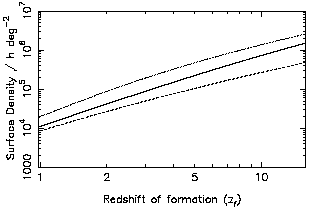


The two fundamental requirements of any PG search are a sound search strategy - covering a sufficient area of sky to a sufficient depth, and an ability to recognise a PG amongst the background of older and more normal galaxies. Therefore, it will be useful to have some idea of what the basic properties of such and object might be.
An estimate of the surface density of PGs on the sky can be made by extrapolating the volume density of local galaxies (~ 0.015h3 Mpc-3) to high redshift. Suppose that all galaxies form at a particular redshift by gravitationally collapsing over a period of 1 Gyr, rapidly forming their first generation of stars: then the resulting areal density of PGs as a function of their formation redshift is shown in Figure 2. PGs should be very abundant irrespective of the uncertainties in the cosmology, with at least 103 in each area of sky the size of the moon!

|
| Figure 2. Expected surface density of PGs as a function of their formation redshift, assuming a collapse time of 1 Gyr. The three curves represent the same cosmologies as in Figure 1. |
This is one of the most difficult properties to estimate. The angular size
of a PG depends upon when the bright phase occurred relative to the
collapse as well as the redshift and cosmology. If the star
formation occurs soon after the onset of collapse then PGs could be
low-surface brightness objects with angular diameters 10-30 arcsec
(Partridge and
Peebles 1967).
At z  5 and with a surface density of
5 and with a surface density of
 105 deg-2
(see Figure 2) PGs would be virtually
overlapping on the sky
and very difficult to detect as discrete sources using conventional
techniques. Possibly the best way
to to detect such objects is to investigate the integrated background
light resulting from such a population of sources and experiments to do
just this have been carried out. At the other extreme is the
idea, stretching back a number of years, that the star formation rate
(hereafter SFR) is closely coupled to the gas density and hence the bulk of
the star formation occurs in the central regions of collapsed PGs
(Eggen et
al. 1962,
Larson 1974).
In this case we can expect the
visible signature of PGs to have an angular diameter
105 deg-2
(see Figure 2) PGs would be virtually
overlapping on the sky
and very difficult to detect as discrete sources using conventional
techniques. Possibly the best way
to to detect such objects is to investigate the integrated background
light resulting from such a population of sources and experiments to do
just this have been carried out. At the other extreme is the
idea, stretching back a number of years, that the star formation rate
(hereafter SFR) is closely coupled to the gas density and hence the bulk of
the star formation occurs in the central regions of collapsed PGs
(Eggen et
al. 1962,
Larson 1974).
In this case we can expect the
visible signature of PGs to have an angular diameter  0.1-0.5
arcsec, making them very difficult to resolve from the ground due to the
limitation imposed by atmospheric ``seeing'' irregularities. Such objects
would be excellent targets for optical satellite missions, such as the
Hubble Space Telescope
with its diffraction-limited 0.1 arcsec imaging capability.
0.1-0.5
arcsec, making them very difficult to resolve from the ground due to the
limitation imposed by atmospheric ``seeing'' irregularities. Such objects
would be excellent targets for optical satellite missions, such as the
Hubble Space Telescope
with its diffraction-limited 0.1 arcsec imaging capability.